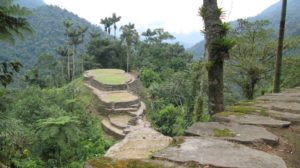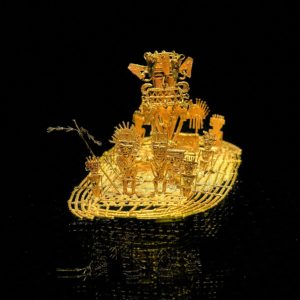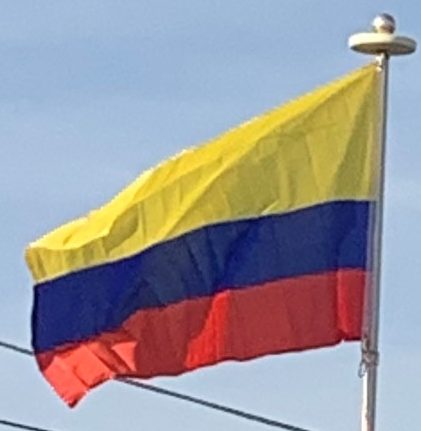
Indigenous people inhabited the territory that is now Colombia by 12,500 BCE. Nomadic hunter-gatherer tribes at the El Abra, Tibitó and Tequendama sites near present-day Bogotá traded with one another and with other cultures from the Magdalena River Valley. Between 5000 and 1000 BCE, hunter-gatherer tribes transitioned to agrarian societies; fixed settlements were established, and pottery appeared. Beginning in the 1st millennium BCE, groups of Amerindians including the Muisca, Zenú, Quimbaya, and Tairona developed the political system of cacicazgos with a pyramidal structure of power headed by caciques. The Muisca inhabited mainly the area of what is now the Departments of Boyacá and Cundinamarca high plateau (Altiplano Cundiboyacense) where they formed the Muisca Confederation. They farmed maize, potato, quinoa, and cotton, and traded gold, emeralds, blankets, ceramic handicrafts, coca and especially rock salt with neighboring nations. The Tairona inhabited northern Colombia in the isolated mountain range of Sierra Nevada de Santa Marta. The Quimbaya inhabited regions of the Cauca River Valley between the Western and Central Ranges of the Colombian Andes. Most of the Amerindians practiced agriculture and the social structure of each indigenous community was different. Some groups of indigenous people such as the Caribs lived in a state of permanent war, but others had less bellicose attitudes. The Incas expanded their empire onto the southwest part of the country.
European Annexation:
Alonso de Ojeda (who had sailed with Columbus) reached the Guajira Peninsula in 1499. Spanish explorers, led by Rodrigo de Bastidas, made the first exploration of the Caribbean coast in 1500. Christopher Columbus navigated near the Caribbean in 1502. In 1508, Vasco Núñez de Balboa accompanied an expedition to the territory through the region of Gulf of Urabá and they founded the town of Santa María la Antigua del Darién in 1510, the first stable settlement on the continent.

Santa Marta was founded in 1525, and Cartagena in 1533. Spanish conquistador Gonzalo Jiménez de Quesada led an expedition to the interior in April 1536, and christened the districts through which he passed “New Kingdom of Granada”. In August 1538, he founded provisionally its capital near the Muisca cacicazgo of Bacatá, and named it “Santa Fe”. The name soon acquired a suffix and was called Santa Fe de Bogotá. Two other notable journeys by early conquistadors to the interior took place in the same period. Sebastián de Belalcázar, conqueror of Quito, traveled north and founded Cali, in 1536, and Popayán, in 1537; from 1536 to 1539, German conquistador Nikolaus Federmann crossed the Llanos Orientales and went over the Cordillera Oriental in a search for El Dorado, the “city of gold”. The legend and the gold would play a pivotal role in luring the Spanish and other Europeans to New Granada during the 16th and 17th centuries.
The conquistadors made frequent alliances with the enemies of different indigenous communities. Indigenous allies were crucial to conquest, as well as to creating and maintaining empire. Indigenous peoples in New Granada experienced a decline in population due to conquest as well as Eurasian diseases, such as smallpox, to which they had no immunity. Regarding the land as deserted, the Spanish Crown sold properties to all persons interested in colonized territories, creating large farms and possession of mines.
